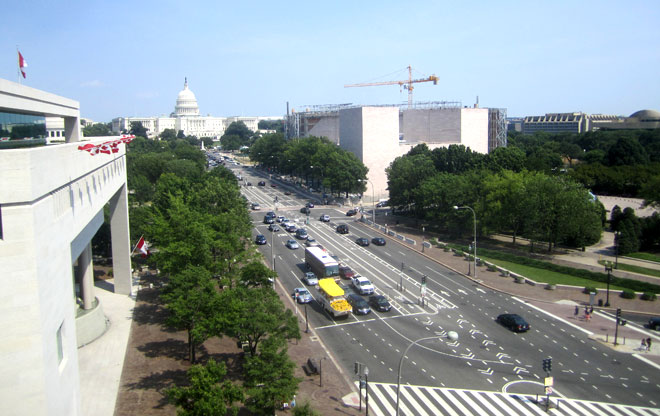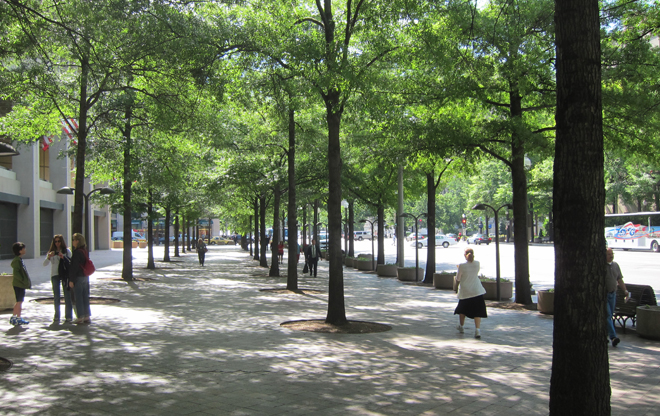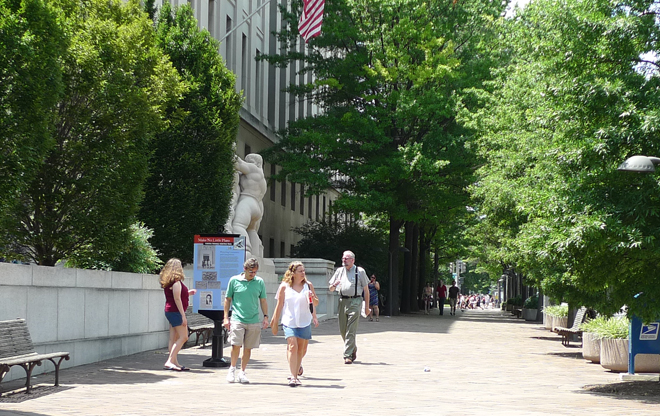
Pennsylvania Avenue
Pennsylvania Avenue is just over 20 miles long, running from Rock Creek Parkway in D.C. on its eastern end to the Patuxent River in Maryland at its western terminus. The 1.2 mile stretch that runs between the White House and the U.S. Capitol building was designated a National Historic Site in 1966, and listed in the National Register of Historic Places in 1990.
Image: The Cultural Landscape Foundation
Van Valkenburgh's Post-9/11 Redesign
The three block portion of Pennsylvania Avenue abutting the Treasury Department and the White House was temporarily closed to vehicles following the Oklahoma bombing in 2005 -- and then closed permanently after 9/11. In 2004, Michael Van Valkenburgh and Associates redesigned the space as a pedestrian promenade.
Image: The Cultural Landscape Foundation
The Council on Pennsylvania Avenue
Members of President John F. Kennedy’s Council on Pennsylvania Avenue included Nathaniel Owings, Dan Kiley, Daniel Patrick Moynihan, and Chloethiel Woodard Smith. The commission’s “Report of the President’s Council on Pennsylvania Avenue” was published in 1964. Recommendations from the report were taken into account by the Pennsylvania Avenue Development Corporation (PADC) after its founding in 1972.
Image: The Cultural Landscape Foundation
A Third Row of Trees
One of the recommendations put forth by the President’s Council on Pennsylvania Avenue was the addition of a third row of trees on the north side of the street. 700 willow oak trees were planted by 1984, under the guidance of the PADC.
Image: The Cultural Landscape Foundation
The Inaugural Parade Route
In 1803, President Thomas Jefferson designated Pennsylvania Avenue an official parade route, planting Lombardy poplars along its length. Since Jefferson’s 1805 inaugural parade, nearly every President has ridden down the iconic street on inauguration day.
Image: The Cultural Landscape Foundation
Statues and Monuments
Statues and monuments dot the avenue, and include memorials to war heroes, and other significant figures in American History. This monument, by sculptor Charles Grafly, appears in front of the U.S. District Courthouse. The statue is a memorial to George Gordon Meade a Union General who defeated Robert E. Lee at the Battle of Gettysburg.
Image: The Cultural Landscape Foundation
First Street in Washington with Streetlights
Street furnishings, granite curbing, and square brown brick pavers were specified by Hideo Sasaki and Associates in the 1980s, when they were hired by the PADC. Pedestrian lighting along the Avenue is a combination of Washington Globe lamps (based on the original 1920 design for the city) and modern two-headed lamps, unique to the city, which were put in place by the PADC. In 1817 Pennsylvania Avenue became the first street in Washington to have streetlights, the only one prior to 1849.
Image: The Cultural Landscape Foundation
U.S. Navy Memorial
Construction of the United States Navy Memorial was approved by Congress in 1980. Constructed as part of the improvements proposed by the PADC, the memorial was dedicated on October 13, 1987. Designed by Conklin Rossant Architects, the memorial includes a statue of a lone sailor and commemorative sculptural relief plaques illustrating naval history and life.
Image: The Cultural Landscape Foundation
Street Improvements
During the 1961 inauguration parade for John F. Kennedy, Kennedy noticed that the Avenue had fallen into disrepair. He created the President’s Council on Pennsylvania Avenue to investigate improvements to the street.
Image: The Cultural Landscape Foundation
One Portion Is 30 Feet Wider
The portion of Pennsylvania Avenue that runs between the U.S. Capitol and the White House is 160 feet wide, 30 feet wider than the 19 miles of avenue that extend beyond the Capitol, terminating at the Patuxent River in Marlboro, Maryland. In its early days the Avenue was little more than a dirt road, changing to gravel before eventually being paved with cobblestones and macadam in the 1830s.
Image: The Cultural Landscape Foundation